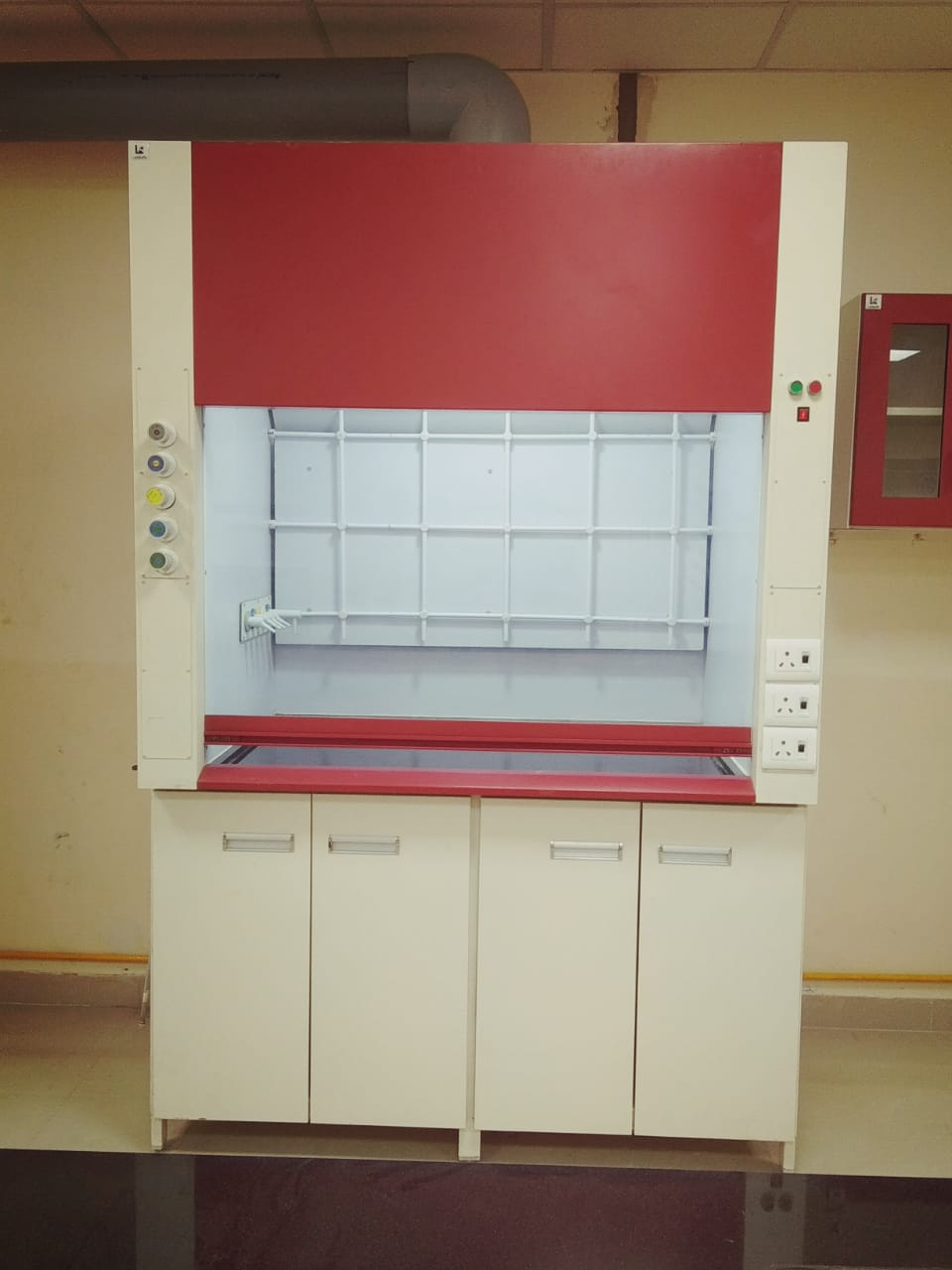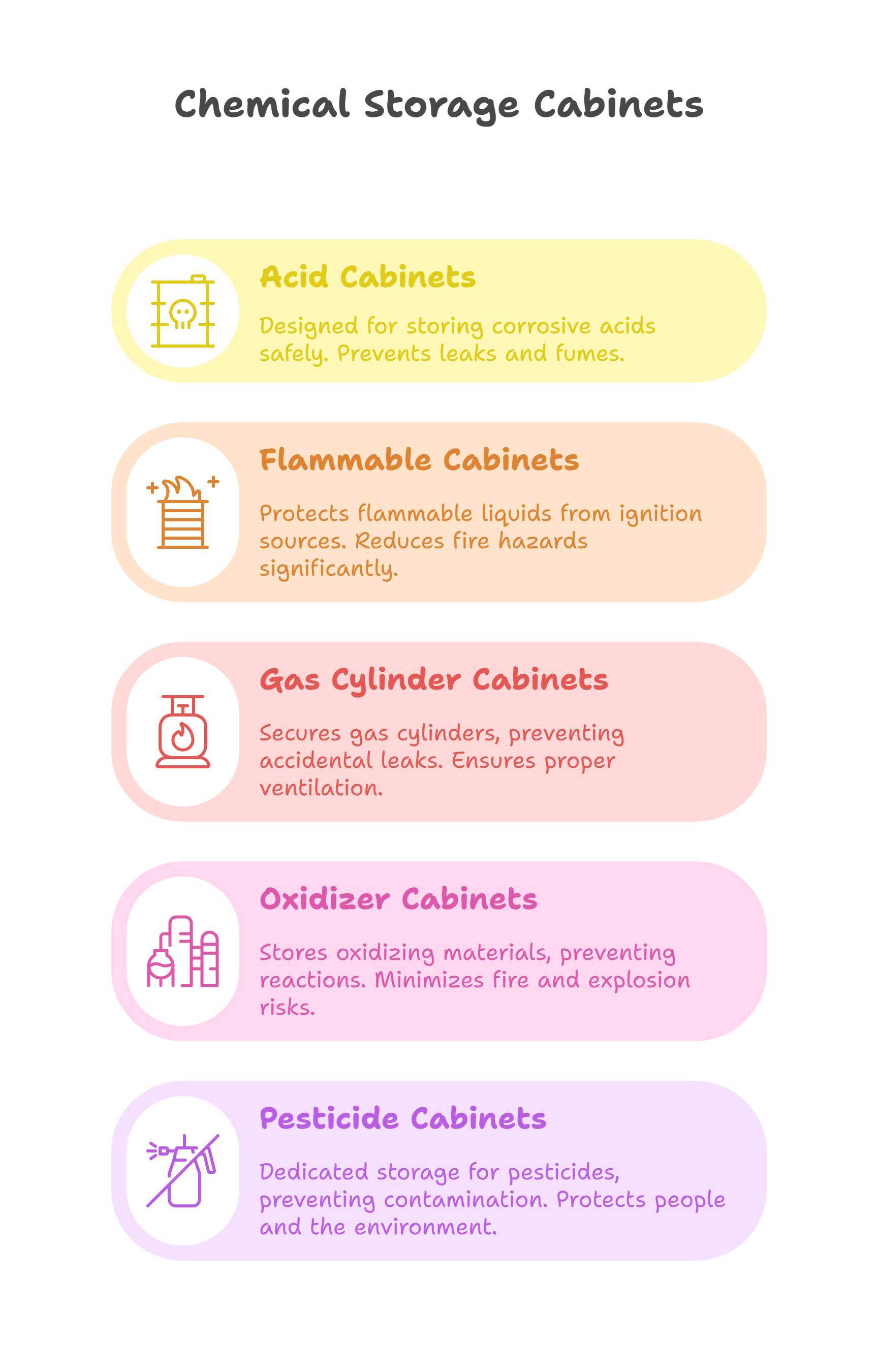You must have come across a Fume Hood in the chemistry lab, but do you know How Fume hood works and its use in a chemical lab?
A fume hood also called “fume cupboard” or “fume closet” is a type of local ventilation that is made to control exposure to hazardous or toxic fumes, vapors, or dust.
There are two main types of Fume Hood, Ducted Fume hood, and Recirculating one which is the ductless Fume hood.
The working principle of fume hood is the same for both the types of fume hood: Air is drawn in from the front which is the open side of the cabinet, either expelled outside the building or made safe through filtration and fed back into the room. So that users can be protected from hazardous fume & gases expelled during any experiment. Secondary functions of Fume Hood may include explosion protection, spill containment, and other necessary lab safety features.
These are generally installed along the walls and are often fitted with infills above, to cover up the exhaust duct pipes. Because of their recessed shape, they are generally poorly lighted by the general room lighting, so many have internal lights with vapor-proof covers. The front is a sash window, usually in glass, able to move up and down on a counterbalance mechanism. On educational versions, the sides and sometimes the back of the unit is also glass, so that several pupils can look into a fume hood at once.
A general picture of Fume Hood may be as follows:

Now coming to the Fume Hoods, the two types are as follows:
1. Ducted Fume Hoods: Industrial processes use mostly these Fume Hoods. A large variety exists. In most designs, conditioned (i.e. heated or cooled) air is drawn from the lab space into the fume hood and then dispersed via ducts into the outside atmosphere.
The fume hood is only one part of the lab ventilation system. Because the recirculation of lab air to the rest of the facility is not permitted, air handling units serving the non-laboratory areas are kept segregated from the laboratory units.
2. Ductless Fume Hoods: These generally have a fan mounted on the top (soffit) of the hood, or beneath the worktop. Air is sucked through the front opening of the hood and through a filter, before passing through the fan and being fed back into the workplace. With a ductless fume hood, it is essential that the filter medium be able to remove the particular hazardous or noxious material being used.
A benefit of ductless fume hoods is that they are mobile, easy to install since they require no ductwork, and can be plugged into a 110 volt or 220-volt outlet.
In a survey (Ref 1.)of 247 lab professionals conducted in 2010, Lab Manager Magazine found that approximately 22% of fume hoods are ductless fume hoods.
Do’s & Don’ts of using fume hood safely in a lab:
Do’s of Using Fume Hood safely in a Lab
- Do all work involving hazardous or volatile materials are inside a fume hood.
- Check that the fume-hood is operating correctly before you start work. To check the airflow, use a strip of paper, tissue, or ribbon can be taped to the fume-hood sash.
- Avoid cross drafts and disruptive air currents in front of the fume hood. Ensure that windows and doors near the fume-hoods are CLOSED.
- Always keep work at least 15cm in from the opening of the fume hood.
- Use the sash as a safety shield when boiling materials or conducting an experiment with reactive chemicals.
- Always keep sash as low as possible. As the sash is lifted, flow is increased so that the face velocity of air over a given cross-section of the sash opening is constant. In summer especially, this will mean that hotter make up air is drawn into the lab.
- When the fume hood is not in use, ensure that all materials are in sealed containers.
- Connect all electrical devices outside of the hood to avoid sparks which may ignite a flammable or explosive chemical.
- Prepare a plan of action in case of an emergency, such as a power failure, especially when using extremely hazardous chemicals or acids.
Don’ts of using fume hood safely in a Lab
- DO NOT place your face or head inside the hood. Keep hands out as much as possible.
- DO NOT use a fume hood as a storage area, they should contain only working volumes of• DO NOT use fume hoods to vent or dispose of hazardous materials through air dilution.
- DO NOT overcrowd or clutter the fume hood. Overcrowding creates vortices and dead spots. Vortices may cause hazardous material to flow back out of the fume hood causing exposure; dead spots may allow ignitable concentrations of flammable and combustible materials to accumulate; Large bulky equipment used in the hood will cause eddies.
- DO NOT place equipment in the hood that stops the sash from closing. A safer local exhaust ventilation method may exist and should be pursued.
- DO NOT modify fume hood or erect shelves in a fume hood for chemical or equipment storage.
- DO NOT place power boards, or other spark-producing sources inside the hood.
How does a fume-hood work?
Fume-hoods draw air out of the rooms they are installed in. There needs to be an adequate volume of air available or the fume-hood will not be able to draw a sufficient volume of air to function properly. Where the room is small or there are a large number of fume-hoods an additional supply of air, other than the normal room ventilation, may be required. This additional air is known as the make-up air. If the make-up air supply is not adequate or the make-up air is switched off then the fume-hoods may not be able to achieve the required face velocity. This can cause fumes to escape into the laboratory. There are special fume hoods for perchloric acid and radioisotopes. Ensure that the appropriate hood is used for each specific reaction or process involving specific chemicals.
Hope this article helps while working with the Fume Hood. Happy Experimenting!
You may also check out our blog on COMMON SCHOOL SCIENCE LABORATORY EQUIPMENT AND THEIR USES
Reference:
Labkafe: Lab Equipment and lab Furniture Manufacturer
We are a School laboratory furniture and Lab equipment manufacturer and supplier.
In laboratory furniture including Fume Hood, Lab Benches, Storage cabinets & Lab Pipeline connections, we first design the entire laboratory room keeping in mind the requirements and budget. Also, we take care of the complete designing and installation of laboratory furniture.
In the lab equipment section, we have a wide range of glassware, chemicals, equipment, and other lab accessories. Most of them are available for order online on our website but some of them can be procured on demand.
If you have need:-
- laboratory equipment or lab furniture requirements for school
- composite lab equipment list for school
- Physics lab equipment list for school
- Chemistry lab equipment list for
- Biology lab equipment list for school
- Pharmacy lab equipment
do drop a message through chat or mail us at [email protected] or call +919147163562 and we’ll get in touch with you.












Leave a Reply